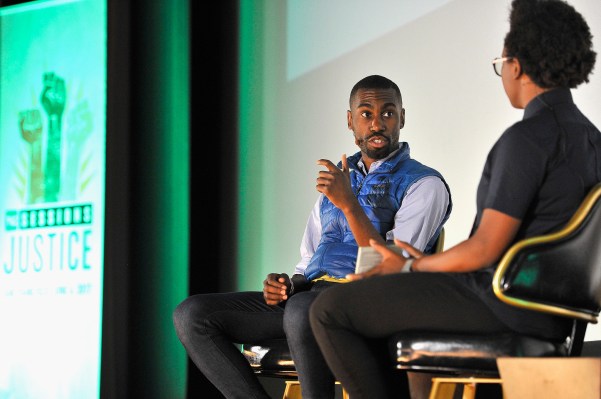DeRay Mckesson has a plan.
The man who became one of the most recognizable faces (and social media voices through his over 800,000 person strong Twitter feed) for the campaign for social justice that launched in the wake of the police killing of Michael Brown in 2014, is thinking about what’s next for the increasingly large community of people in the United States advocating for change under the banner of the Campaign Zero program he helped articulate.
In a wide-ranging conversation at our TC Justice event in San Francisco, Mckesson touched on everything from Edward Snowden’s racial sensitivities (he’s learning); to how “woke” Jack Dorsey is (he’s woke); to whether Bill Maher should remain on the air (he shouldn’t).
But critically and crucially, Mckesson returned again and again to the need for the current movement advocating for social justice to push past protest and focus on an engagement with the issues and the levers of government that can effect change most effectively.
“I hope that people learn,” Mckesson said. “We’re explaining the trauma that’s happening…. rather than trying to engage in ways to address it.”
That’s one of the reasons that Mckesson has launched his new podcast, Pod Save the People with the folks at Crooked Media, and why Campaign Zero — the site that’s become a go-to resource for organizing — is going to launch a new project in the coming months around what Mckesson refers to as capacity building.
It’s important to note that the plan is not Mckesson’s alone. He’s quick to point out that the movement that came together in the wake of a spate of police killings of predominantly black men throughout 2014 has a number of architects. They include Brittany Packnett, and Samuel Sinyangwe along with Mckesson and Johnetta Elzie (it’s this group of four that co-founded the “Mapping Police Violence” project in April 2015).
Now, as the movement becomes a campaign, it’s more important than ever for the communities that are fighting for social justice and their allies look beyond the streets to the statehouses, city councils, and congressional seats where policies are made and oversight is required of the arms of government that project power, Mckesson said.
“There is a way to appreciate the activism without glorifying the action,” Mckesson said. “Activism in the street is truth-telling and organizing is talking to people for a specific goal.”
The goal with the capacity building component of the Campaign Zero platform will be to provide educational tools that can teach people how to organize meetings effectively, plan grassroots campaigns, and foster community engagement to bring people together to create more effective political action.
The messaging, the media, and the movement need to evolve beyond simply telling the truth about the traumas of being discriminated against or actually attacked because of race, sex, or gender identities, to organizing communities that empower agency to try and ensure that those attacks don’t happen.
In many instances, that involves letting these communities have their space within the broader movement toward a more equitable America.
“We have to create a world where people can show up as whole people every single time,” Mckesson said.
It also means reaching out to potential allies, with narratives that can enlighten them about the ways their privilege can operate… and obfuscate critical issues.
“How hard did your father work for every band aid to be he color of his skin?” Mckesson asked rhetorically. “[Identifying ] that is the work that needs to be done to make sure that people understand that this is systemic and deep,” he said.
Finally, Mckesson also talked abut the difference between equity and equality and drew an important distinction between the two.
“The difference between equity and equality is that equality is everyone get the same thing and equity is everyone get the things they deserve,” Mckesson said.
